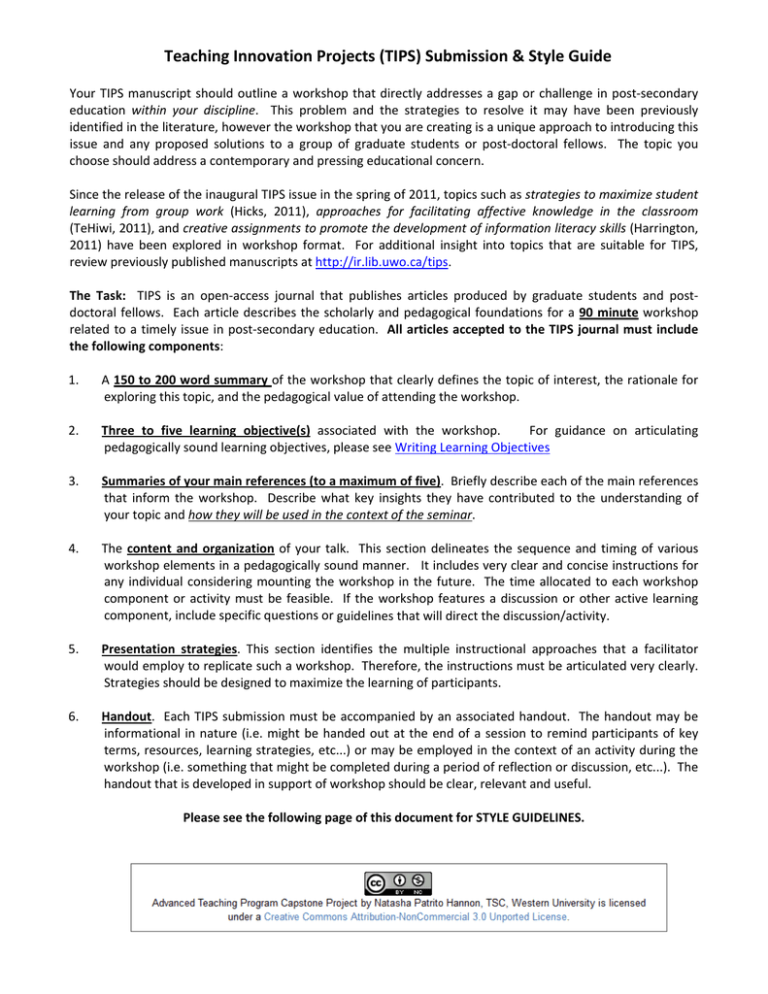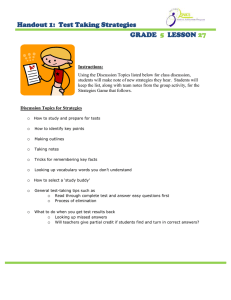Teaching Innovation Projects (TIPS) Submission & Style Guide
advertisement

Teaching Innovation Projects (TIPS) Submission & Style Guide Your TIPS manuscript should outline a workshop that directly addresses a gap or challenge in post‐secondary education within your discipline. This problem and the strategies to resolve it may have been previously identified in the literature, however the workshop that you are creating is a unique approach to introducing this issue and any proposed solutions to a group of graduate students or post‐doctoral fellows. The topic you choose should address a contemporary and pressing educational concern. Since the release of the inaugural TIPS issue in the spring of 2011, topics such as strategies to maximize student learning from group work (Hicks, 2011), approaches for facilitating affective knowledge in the classroom (TeHiwi, 2011), and creative assignments to promote the development of information literacy skills (Harrington, 2011) have been explored in workshop format. For additional insight into topics that are suitable for TIPS, review previously published manuscripts at http://ir.lib.uwo.ca/tips. The Task: TIPS is an open‐access journal that publishes articles produced by graduate students and post‐ doctoral fellows. Each article describes the scholarly and pedagogical foundations for a 90 minute workshop related to a timely issue in post‐secondary education. All articles accepted to the TIPS journal must include the following components: 1. A 150 to 200 word summary of the workshop that clearly defines the topic of interest, the rationale for exploring this topic, and the pedagogical value of attending the workshop. 2. Three to five learning objective(s) associated with the workshop. For guidance on articulating pedagogically sound learning objectives, please see Writing Learning Objectives 3. Summaries of your main references (to a maximum of five). Briefly describe each of the main references that inform the workshop. Describe what key insights they have contributed to the understanding of your topic and how they will be used in the context of the seminar. 4. The content and organization of your talk. This section delineates the sequence and timing of various workshop elements in a pedagogically sound manner. It includes very clear and concise instructions for any individual considering mounting the workshop in the future. The time allocated to each workshop component or activity must be feasible. If the workshop features a discussion or other active learning component, include specific questions or guidelines that will direct the discussion/activity. 5. Presentation strategies. This section identifies the multiple instructional approaches that a facilitator would employ to replicate such a workshop. Therefore, the instructions must be articulated very clearly. Strategies should be designed to maximize the learning of participants. 6. Handout. Each TIPS submission must be accompanied by an associated handout. The handout may be informational in nature (i.e. might be handed out at the end of a session to remind participants of key terms, resources, learning strategies, etc...) or may be employed in the context of an activity during the workshop (i.e. something that might be completed during a period of reflection or discussion, etc...). The handout that is developed in support of workshop should be clear, relevant and useful. Please see the following page of this document for STYLE GUIDELINES. Teaching Innovation Projects (TIPS) Submission & Style Guide TIPS Manuscript Style Requirements • Margins should be one inch (2.5cm) at the top, bottom, and sides of the page. • Each page of the manuscript must include a footer with the author’s name, email address, university affiliation, and page number. • Font type must be 12‐point Arial throughout the document. • All body text must be single spaced and justified. • TIPS is an academic journal and thus the writing must be formal. For example, avoid the use of contractions (I am, not I’m) and phrasal verbs such as ‘plays out’. • TIPS uses only one level of heading. Headings designate your major sections and should be consistent. Align headings to the left of the page and use all capitals. Every TIPS article should include the following headings: SUMMARY LEARNING OBJECTIVES REFERENCE SUMMARIES CONTENT AND ORGANIZATION PRESENTATION STRATEGIES HANDOUT • The CONTENT AND ORGANIZATION section should be formatted as a table with the following four column headings: DURATION (Length of time devoted to this component of seminar) SUBJECT (Key topic or issue of focus for that duration) ACTIVITY (What will the presenter or participants be doing during that time?) PURPOSE (What is the intended outcome of that activity?) • All references should be formatted according to APA guidelines – please refer to these at http://owl.english.purdue.edu/owl/resource/560/07/. • If additional references beyond those described in the REFERENCE SUMMARIES section have been used or would be of use to the audience, please include these in an ADDITIONAL REFERENCES section at the end of the submission. • Any additional resources, including the HANDOUT, case studies, etc… that the author deems necessary for the support/completion of their seminar description are free from the above formatting rules. They can be formatted in any way that suits the needs of the author and potential seminar participants. Resources beyond the HANDOUT should be included in an APPENDIX section at the end of the article. While the appendices are free from formatting rules, clarity and organization will remain of paramount importance.

